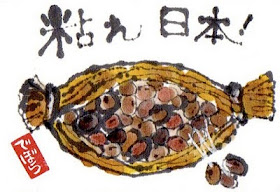Today's guest is Debbie from Dosankodebbie's Etegami Notebook and is a fellow Etsy Japan team member. Debbie is a crafty soul who has spent most of her life on the island of Hokkaido, in the north of Japan, today she is going to share with you her love of the Japanese etagami postcard.
Welcome to the World of Etegami
I was born in Japan of non-Japanese parents, and have lived here now for half-a-century. That, and the fact that one of my parents was an artist, provided me with the perfect setting to soak in much of the rich and varied artistic traditions of my birth country. But it wasn’t until I tried my hand at etegami, that I found an art form that I wanted to practice for a lifetime.
The technique of traditional etegami usually involves (1) the wobbly, blotchy lines of inconsistent thickness called “living lines” that result from very, verrrry slow strokes of the ink brush when forming the outline of the image, (2) "laying" the colors on the card with your brush, and letting the color spread naturally according to the character of the washi paper used, rather than using strokes to spread the colors, (3) using a limited range of colors (three, at the most), and making these colors darker or lighter by judicious use of water, rather than by mixing different colors together, (4) leaving some uncolored areas within the outline of the image, rather than completely filling it in, and (5) leaving the background of the image blank.
However, I should add that etegami can be done on any kind of paper, with any kind of tools, and practically any technique. If you use paper that has very little “bleed,” simply “laying” the paint on the card may not work very well, so of course, in that case, you will have to use strokes. You can make etegami with crayons on cardboard, for that matter.
But it isn't etegami without the addition of words. And it isn't really etegami unless it is in a form that can be sent to someone through the postal system, although this does not necessarily limit it to postcards. Etegami can be sent in, or even painted on, an envelope. Digital artwork accompanied by words and emailed to someone could be considered etegami.I started my blog, “dosankodebbie’s etegami notebook,” to introduce the world of etegami to the West. This is where I post samples of my work and discuss tools and techniques. I also have an Etsy shop, Dosankodebbie for those love the etegami style, but prefer to buy art rather than making it themselves.







Wow, I really love this! I hadn't heard of this art form and I look forward to sharing it with my illustrator husband. Thank you Debbie!
ReplyDeleteWhat a sublime art. I'll definitely try it this weekend. :)
ReplyDeleteLadies, thank you for your responses to my guest post! I'm glad the concept of etegami grabs you. Don't let the lack of specific tools or materials stop you from giving it a try! You might get hooked for life, as I did. :D
ReplyDeleteyou do make it look so easy! I think ebi-kun and I will be giving it go. thank you for taking part xx
ReplyDeleteIncredible I love your post and very intrigued by etegami. I love how you referenced Mma Ramotswe and Rooibos tea, it's funny how Rooibos tea became so popular internationally, it's such an African tea, been drinking it since I was a child. Your post is brilliant, thanks for the post.
ReplyDeleteThanks jo and @ebbye. One reason Etegami appeals to me so much is that is involves words, not just images. The combination of words and images gives me greater scope for expression of my feelings and thoughts. These days whenever I read a book or poem, or watch a movie, or listen to music, I always have an antenna up for etegami material.
ReplyDeleteI love your poem! May I use it in an artist trading card (ATC)? I will give you credit with a link.
ReplyDeleteI'm making an ATC every day. http://atcaday.blogspot.com/
Though I am a bit behind at the moment...
Thanks!
Diane
Thanks to Susan Gaylord and her bookmaking site, I came to visit the New Skills Festival. And very grateful thanks to the NSF, I have connected with Debbie and the Etegami Fun Club and am actually making etegami instead of just thinking about it. So you never know how your postings on the WWW will affect another person's life. Thank you so much for the Festival and the connection I needed.
ReplyDeleteRachel - that is great news!
ReplyDeleteJo, we've had several new people join the Etegami Fun Club on Facebook, and after reading Rachel's comment, I realize it must be in large part thanks to the exposure you gave Etegami here on your website. Thanks from all of us who love Etegami! ♥
ReplyDeleteThese are simply beautiful.
ReplyDeleteI had not heard of this art form, but I love the idea and plan to try it. I already do a lot of mail art, and like to try new things in it. Thanks for the information!
ReplyDelete